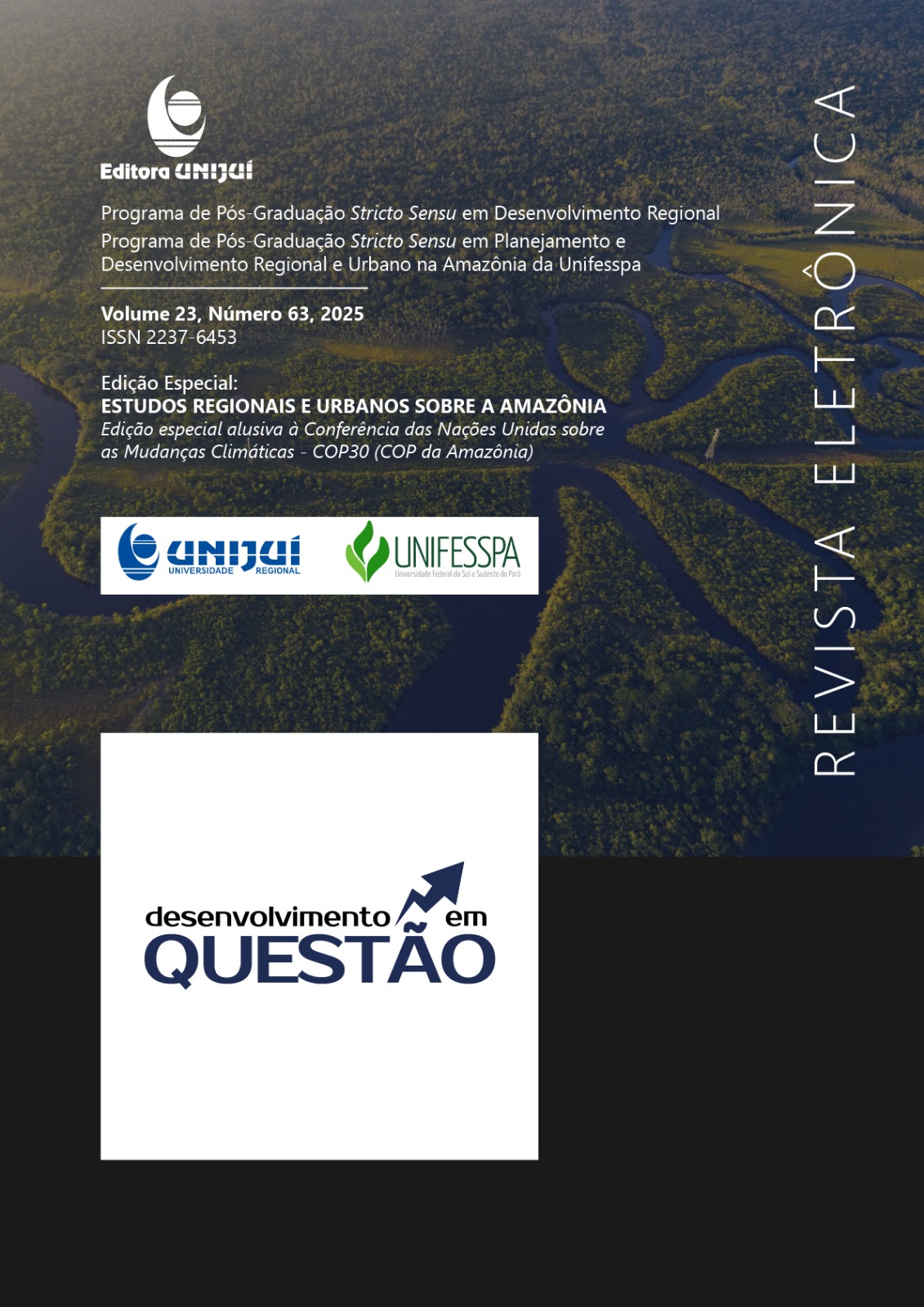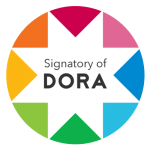Infraestrutura e sistemas socioprodutivos: Desafios para a gestão integrada em áreas protegidas do Mosaico do Baixo Rio Negro
DOI:
https://doi.org/10.21527/2237-6453.2025.63.16787Palavras-chave:
Amazônia Central, socioeconomia, desenvolvimento rural, Unidades de ConservaçãoResumo
Os Mosaicos de Áreas Protegidas surgem como uma abordagem para fortalecer a gestão das áreas protegidas no Brasil, visando uma governança mais eficaz por meio da integração territorial. Trazemos o caso do Mosaico do Baixo Rio Negro (MBRN), no Amazonas, para a reflexão sobre os desafios da gestão integrada em Unidades de Conservação com populações residentes. Através de questionários estruturados aplicados em 115 comunidades tradicionais de oito Unidades de Conservação do MBRN em 2022, caracterizamos as práticas produtivas e o acesso à itens de infraestrutura comunitária. Posteriormente, testamos a hipótese de que comunidades maiores e com mais itens de infraestrutura comunitária apresentam mais práticas produtivas. Detectamos que práticas como a agricultura, pesca, artesanato e extrativismo foram homogêneas ao longo do território, enquanto atividades turísticas, manejo de recursos naturais e pecuária foram desenvolvidos em territórios específicos. Nenhuma Unidade de Conservação pode ser caracterizada como excelente em relação ao acesso à infraestrutura, evidenciando a precariedade dos serviços na região. Constatamos que o acesso à itens de infraestrutura comunitária possibilita o desenvolvimento de mais práticas produtivas, independentemente do tamanho da comunidade. O território do MBRN revelou grande heterogeneidade no acesso à infraestrutura comunitária e nos sistemas socioprodutivos, o que dificulta a implementação de estratégias de gestão integrada. Ressaltamos o desafio significativo na gestão conjunta do território para garantir a qualidade de vida e conservar a sociobiodiversidade amazônica.
Referências
ABRAMOVAY R. et al. Chapter 30: The New Bioeconomy in the Amazon: Opportunities and Challenges for a Healthy Standing Forest and Flowing Rivers. In: NOBRE C. et al. (Eds). Amazon Assessment Report. United Nations Sustainable Development Solutions Network, New York, USA. 2021. Available at: https://www.theamazonwewant.org/spa-reports/. DOI: 10.55161/UGHK1968.
ALVES, J. D. G.; CÔRTES, J. C.; D’ANTONA, Á. O. Expansão da COVID - em Unidades de Conservação na Amazônia: implicações para a mobilidade espacial da população no Mosaico do Baixo Rio Negro. Terra Livre, [S. l.], [s.d.]. Available at: https://publicacoes.agb.org.br/terralivre/article/view/2933.
ALVES, J. D. G.; PEREIRA, H. C. Populações tradicionais e os efeitos das mudanças climáticas no Mosaico de Áreas Protegidas do Baixo Rio Negro (MBRN). In: SIMONETTI, S. R; PEREIRA, H. S.; BARBOSA, D. E. S (org) Autogestão e desenvolvimento territorial sustentável de áreas protegidas: diálogos, aprendizagens e resiliência. Manaus, AM: EDUA, 2023. p. 16 – 33.
BANDURA R.; MCKEOWN S. Sustainable Infrastructure in the Amazon Connecting Environmental Preservation with Governance, Security, and Economic Development. Center for Strategic and International Studies. Washington, USA. p.80, 2020. Available at: https://csis-website-prod.s3.amazonaws.com/s3fspublic/publication/201022_Bandura_Sustainable%20Infrastructure_Amazon
BARRETTO FILHO, H. T. et al. Chapter 31: Strengthening Governance and Management of Lands and Natural Resources: Protected Areas, Indigenous Lands, and Local Communities’ Territories. 2021. In: NOBRE C. et al. (ed). Amazon Assessment Report. United Nations Sustainable Development Solutions Network, New York, USA. 2021. Available at: https://www.theamazonwewant.org/spa-reports/. DOI: 10.55161/NQBA9165.
BITTENCOURT, F., POTIGUAR, M.; FERNANDES, T. Cadeia de valor do açaí: articulação e acesso aos benefícios. In: MARCOVITCH, J.; VAL, A. L. Bioeconomia para quem? Bases para um desenvolvimento sustentável na Amazônia. São Paulo, Com-Arte, 387p. 2024.
CAMPOS-SILVA, J. V. et al. Sustainable-Use Protected Areas Catalyze Enhanced Livelihoods in Rural Amazonia. Proceedings of the National Academy of Sciences, v. 118, n 40. 2021. https://doi.org/10.1073/pnas.2105480118.
COOK, P. Infrastructure, rural electrification and development. Energy for Sustainable Development, v.15, p. 304-313. 2011.
CÔRTES, J. C.; ALVES, J. D. G.; D'ANTONA, A. O. Rede urbana na Amazônia e vulnerabilidades de populações tradicionais: desigualdades no contexto da gestão de áreas protegidas. In: Anais do X Congreso da Asociación Latinoamericana de Población (ALAP) Valparíso, Chile, 2022.
D'ANTONA, A. O. Conservação ambiental, mobilidade espacial e condições de vida de populações tradicionais em áreas protegidas: por modelos de acesso à saúde adequados ao quadro amazônico. Cadernos de Saúde Pública, v. 39, p. 1-6, 2023.
D’ANTONA, A. O., ALVES, J. D. G. The use of computer tablets in sociodemographic surveys under unfavorable field conditions - an application in land use and cover change studies in the Amazon. International Journal of Social Research Methodology, v. 1, p. 1-11, 2023.
DA-GLORIA, P.; PIPERATA, B. A. Modos de vida dos ribeirinhos da Amazônia sob uma abordagem biocultural. Ciência e Cultura, São Paulo, v. 71, n. 2, p. 45-51. 2019. Available at: http://cienciaecultura.bvs.br/scielo.php?script=sci_arttext&pid=S0009-67252019000200014&lng=en&nrm=iso.
DIDIER, K. et al. O Mosaico do Baixo Rio Negro e o seu Plano de Monitoramento. In: DIDIER K, ESTUPIÑÁN G.M.B. (ed.). Plano de Monitoramento do Mosaico de Áreas Protegidas do Baixo Rio Negro, Amazonas, Brasil. Wildlife Conservation Society (WCS Brasil) e o Conselho do Mosaico do Baixo Rio Negro, Manaus, Amazonas, Brasil. 2017. p. 5 – 35.
GOVERNO DO ESTADO DO AMAZONAS. Decreto n° 22.747, de 26 de junho de 2002. Regulamenta a pesca esportiva, recreativa e de subsistência no Estado do Amazonas. 2002.
GUALBERTO, C. G.; ESTUPIÑAN, G. M. B. Cap 5 - Plano de Monitoramento da Pesca do Mosaico do Baixo Rio Negro, Amazonas, Brasil. In DIDIER, K.; ESTUPIÑÁN, G. M. B. (Eds.) Plano de Monitoramento do Mosaico de Áreas Protegidas do Baixo Rio Negro, Amazonas, Brasil. Wildlife Conservation Society (WCS Brasil) e o Conselho do Mosaico do Baixo Rio Negro, Manaus, Amazonas, Brasil. 2017. p. 121 – 146.
GUINATO, R. B. et al. Caracterização socioeconômica de comunidades tradicionais do Mosaico do Baixo Rio Negro. Terra Livre, São Paulo, a. 38, v.2, n. 61, p. 639-682. 2023.
GUINATO, R. B.; LOUREIRO, L. F.; CORRÊA, D. S. S. Impactos da ausência de infraestrutura para o desenvolvimento socioeconômico da Amazônia. InterAção, [S. l.], v. 16, n. 1, p. e90039, 2025. DOI: 10.5902/2357797590039.
GURDAK, D. J. et al. Diversity in reproductive traits of arapaima (Arapaima spp., Müller, 1843) in Amazonian várzea floodplains: Conservation implications. Aquatic Conservation: Marine and Freshwater Ecosystem, e. 29, p. 245-257. 2019. DOI: https://doi.org/10.1002/aqc.3030
HANUSCH, M. A Balancing Act for Brazil’s Amazonian States: An Economic Memorandum. International Development in Focus. Washington, DC: World Bank. 2023. DOI:10.1596/978-1-4648-1909-4.
IBGE. Amazônia Legal. 2024. Disponível em: https://www.ibge.gov.br/geociencias/cartas-e-mapas/mapas-regionais/15819-amazonia-legal.html. Acesso em: 9 set. 2025.
IWAMOTO, H, M.; LEAL, V. A.; CANÇADO, A. C. Jalapão Mosaic: Perspectives and Challenges for Implementing the Sustainable Development Goals (SDGs). Sociedade & Natureza, v. 36, p. 1-13. 2024. DOI: 10.14393/SN-v36-2024-70921
LEVIS, C. et al. Help restore Brazil’s governance of globally important ecosystem services. Nature Ecology & Evolution, v.4, n.2, p.172–173. 2020. https://doi.org/10.1038/s41559-019-1093-x.
LIMA, D.; POZZOBON, J. Amazônia socioambiental: sustentabilidade ecológica e diversidade social. Estudos Avançados, São Paulo, Brasil, v. 19, n. 54, p. 45–76, 2005. Available at: https://www.revistas.usp.br/eav/article/view/10070.
MINISTÉRIO DO MEIO AMBIENTE - Portaria Nº 483, De 14 De Dezembro De 2010. Reconhece o Mosaico do Baixo Rio Negro. Available at: <https://antigo.mma.gov.br/estruturas/240/_arquivos/portaria_baixo_rio_negro_240.pdf>
MINISTÉRIO DO MEIO AMBIENTE - Instituto Chico Mendes de Conservação da Biodiversidade. Instrução Normativa Nº 16, de 4 de Agosto de 2011. Regula, no âmbito do Instituto Chico Mendes, as diretrizes e os procedimentos administrativos para a aprovação do Plano de Manejo Florestal Sustentável (PMFS) comunitário para exploração de recursos madeireiros no interior de Reserva Extrativista, Reserva de Desenvolvimento Sustentável e Floresta Nacional. 2011.
MOURA, E. A. F. et al. (Orgs.) Sociodemografia da Reserva de Desenvolvimento Sustentável Mamirauá: 2001- 2011. Tefé: Instituto de Desenvolvimento Sustentável Mamirauá; Belém: IDSM; NAEA; 2016.
NASCIMENTO, A. C. S. et al. (Orgs.) Sociobiodiversidade Da Reserva De Desenvolvimento Sustentável Amanã (1998-2018): 20 Anos De Pesquisas. Tefé/Am: IDSM. v.1. 2019. Available at: https://www.mamiraua.org.br/documentos/1a8fb464341de84156fef2c2eb778be3.pdf
PERALTA, N.; LIMA, D. M. A Comprehensive Overview of The Domestic Economy in Mamirauá and Amanã in 2010. Uakari, v.9, n.2, p. 33-62. 2013. https://Doi.Org/10.31420/Uakari.V9i2.155.
PEREIRA, H. C. et al. Migração rural-urbana por demanda educacional no Médio Solimões, Amazonas. Revista brasileira de educação, v. 27, p. 1-26, 2022.
SANTOS, D. Fatos da Amazônia - Socioeconomia. Projeto Amazônia 2030. p.107. 2020. Available at: https: www.amazonia2030.org.br
SANTOS, D.; SANTOS, M. L.; VERÍSSIMO, B. Fatos da Amazônia - Socioeconomia. Projeto Amazônia 2030. 2022. Available at: https://amazonia2030.org.br/fatos-da-amazonia-socioeconomia/
SILVA, A. T. R. Áreas Protegidas, populações tradicionais da Amazônia e novos arranjos conservacionistas. Revista Brasileira de Ciências Sociais, v. 34, n. 99. 2019. DOI: 10.1590/349905/2019.
SNUC - Sistema Nacional de Unidades de Conservação. Brasil, Lei no 9.985, de 18 de julho de 2000 - institui o Sistema Nacional de Unidades de Conservação da Natureza e dá outras providências. 2000.
SOARES, L. M. O.; MIRANDA, G. E. C.; MOURÃO, J. S. An empirical analysis of the management model practiced in Protected Areas of Sustainable Use. Sociedade & Natureza, v. 32, p. 472-483. 2020.
TURLEY, L.; UZSOKI, D. Financing rural infrastructure: priorities and pathways for ending hunger. The International Institute for Sustainable Development. 2018.
UMA CONCERTAÇÃO PELA AMAZÔNIA (Org.). Bioeconomia: a evolução do debate e repercussões nas Amazônias. São Paulo: Arapyaú, Cadernos da Concertação, n.2. 2023.
UNEP-WCMC, IUCN. Protected Planet Report 2020. Cambridge and Gland, 2021. Available at: https://www. unep.org/pt-br/resources/relatorio-planeta-protegido-2020.
VILLAR, P. F. et al. PROTOCOL: The effects of agricultural output market access interventions on agricultural, socio‐economic and food and nutrition security outcomes in low‐ and middle‐income countries: A systematic review. Campbell Systematic Reviews, v.19, e.1348. 2023. DOI: https://doi.org/10.1002/cl2.1
Downloads
Publicado
Como Citar
Edição
Seção
Licença
Copyright (c) 2025 Rayssa Bernardi Guinato, José Diego Gobbo Alves, Ana Claudeise Silva do Nascimento, Alvaro de Oliveira D'Antona

Este trabalho está licenciado sob uma licença Creative Commons Attribution 4.0 International License.
Ao publicar na Revista Desenvolvimento em Questão, os autores concordam com os seguintes termos:
Os trabalhos seguem a licença Creative Commons Atribuição 4.0 Internacional (CC BY 4.0), que permite:
Compartilhar — copiar e redistribuir o material em qualquer meio ou formato;
Adaptar — remixar, transformar e criar a partir do material para qualquer fim, inclusive comercial.
Essas permissões são irrevogáveis, desde que respeitados os seguintes termos:
Atribuição — Atribuição — os autores devem ser devidamente creditados, com link para a licença e indicação de eventuais alterações realizadas.
Sem restrições adicionais — não podem ser aplicadas condições legais ou tecnológicas que restrinjam o uso permitido pela licença.
Avisos:
A licença não se aplica a elementos em domínio público ou cobertos por exceções legais.
A licença não garante todos os direitos necessários para usos específicos (ex.: direitos de imagem, privacidade ou morais).
A revista não se responsabiliza pelas opiniões expressas nos artigos, que são de exclusiva responsabilidade dos autores. O Editor, com o apoio do Comitê Editorial, reserva-se o direito de sugerir ou solicitar modificações quando necessário.
Somente serão aceitos artigos científicos originais, com resultados de pesquisas de interesse que não tenham sido publicados nem submetidos simultaneamente a outro periódico com o mesmo objetivo.
A menção a marcas comerciais ou produtos específicos destina-se apenas à identificação, sem qualquer vínculo promocional por parte dos autores ou da revista.
Contrato de Licença (para artigos publicados a partir de 2025): Os autores mantêm os direitos autorais sobre seu artigo, e concedem a Revista Desenvolvimento em Questão o direito de primeira publicação.











